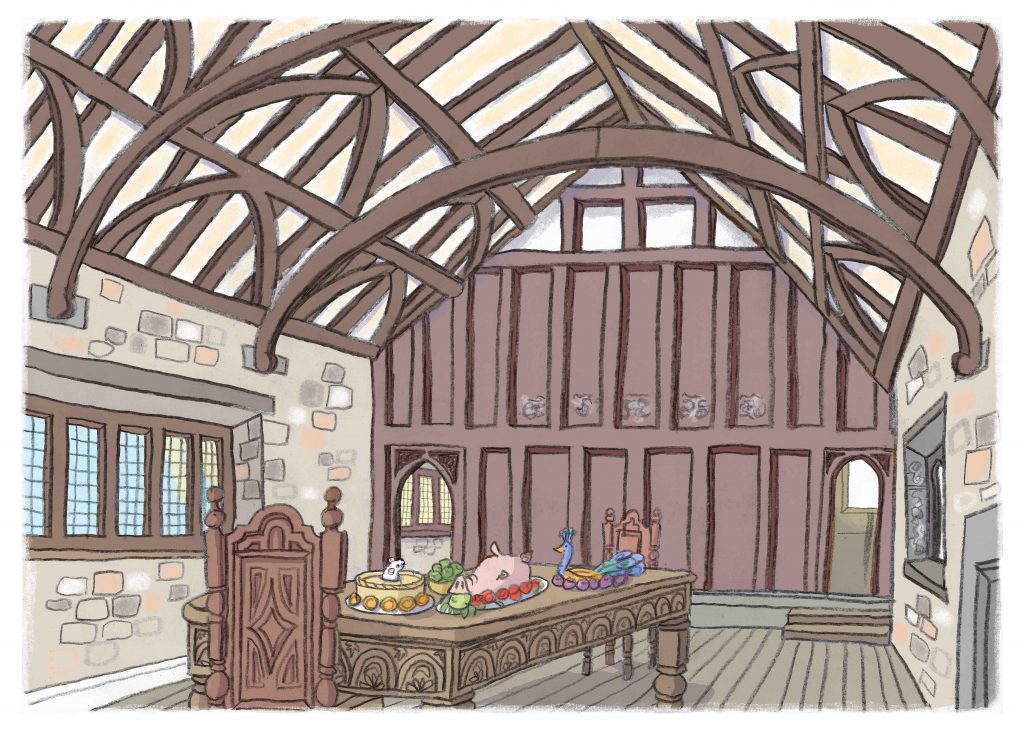History
The Eastern end of the refectory wing showing the oriel extension Battle Abbey, near Hastings was endowed with the church of St Olave’s in Exeter and monks were sent to serve the church. In 1087 these monks formed a new monastic community and dedicated their church to St Nicholas. The monks were members of the Benedictine order. It remained a small community. For over 500 years they worshipped, studied, served the poor and offered hospitality.
As was the tradition with medieval monasteries the buildings were laid out around a cloister square, but unusually the church was to the south and the refectory range (21 The Mint) to the north. Beyond were a cemetery, gardens and an orchard, the whole enclosed by a stone boundary wall. The maintenance of the Priory relied on its various endowments of properties which made up its estate mainly in and around Exeter.
Following the Dissolution in 1536, the monks were pensioned off. The church, adjoining Chapter House, dormitory and cloisters were pulled down, but leaving the outline of the cloisters. The Northern and Western ranges survived and were sold off by the Crown, passing through several hands until 1562, when the estate passed into the ownership of one, Robert Mallet, a wealthy Somerset gentleman, whose family retained much of the site for the next 200 years, leasing it out.
In the later 16th century these two buildings were converted into a single large mansion but, in the mid 17th century, the property was again divided and became two independent dwellings. The Refectory hall itself was sub-divided into several storeys, with rooms on three floors, including in the arch-braced roof space. Mint Lane was also created at this time, cutting through the Western side of the former cloister and the Hall’s screens passage where it abutted the old monastery kitchen.
Then followed multiple occupation until 1775 when a tenancy was taken of what became No 21 by the Roman Catholic Mission. A priest was installed and a ‘large upper chamber’ was formed into a chapel where mass could be said.
In 1786 Lord Hugh Clifford of Chudleigh bought the range and garden (severing the last link with the Mallets) for the permanent use of the Catholics and two years later oversaw the building of the Roman Catholic church on the site of the medieval Chapter House. In 1855 the purpose-built Roman Catholic school of St. Nicholas was opened, facing the Refectory. Nuns came to teach the pupils.

The much-loved Reverend Dr George Oliver (see plaque on Mint Lane wall) was the Parish priest here from 1807 to 1851 and then, in retirement, lived a further ten years in ‘The dwelling house’ over the arch in Mint Lane. Following his death, the medieval arch and rooms were pulled down to widen the Lane in 1864.
In 1877 Lord Clifford gave the Deeds of “The Presbytery” No 21, the church and school to the Roman Catholic Bishop of Plymouth; the Diocese still owns the Freehold.
The Catholic presence ceased in 1959 when the school moved to premises in Holloway Street (The Roman Catholic church had been vacated in 1884 – later to be utilized by the school) but the school caretaker remained in occupation.
No. 21 and the old church were leased to The Exeter College of Art & Design from 1970 – 1989 for use as their printing department.
In 1991 the Roman Catholic Diocesan Trust put the empty and deteriorating buildings on the market.
Illustrations by Olivia Palmer
Olivia has been drawing for as long as she can remember. In 2014, she was one of the winning illustrators in the Society of Children’s Book Writers and Illustrators Undiscovered Voices competition. She is now represented by the Plum Pudding Illustration Agency, and has done illustrations for publishers and the heritage industry. She loves sketching out of doors and drawing buildings.



